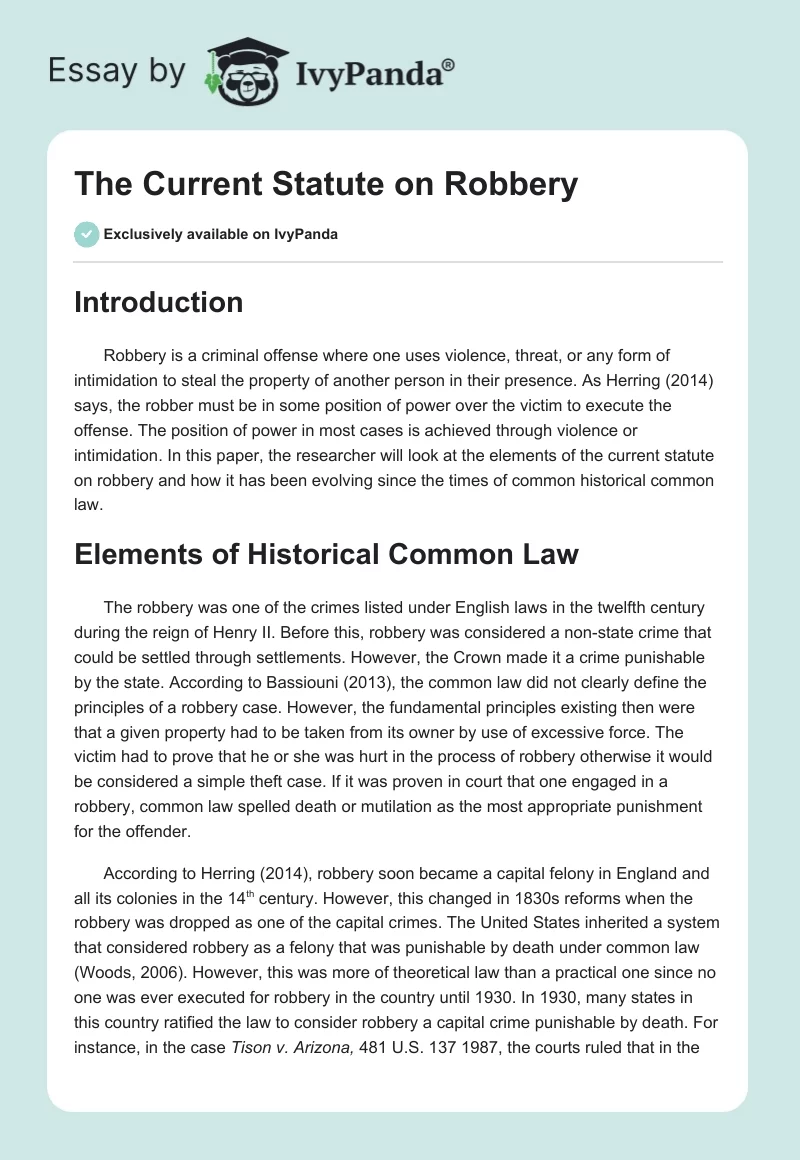Introduction
Robbery is a criminal offense where one uses violence, threat, or any form of intimidation to steal the property of another person in their presence. As Herring (2014) says, the robber must be in some position of power over the victim to execute the offense. The position of power in most cases is achieved through violence or intimidation. In this paper, the researcher will look at the elements of the current statute on robbery and how it has been evolving since the times of common historical common law.
Elements of Historical Common Law
The robbery was one of the crimes listed under English laws in the twelfth century during the reign of Henry II. Before this, robbery was considered a non-state crime that could be settled through settlements. However, the Crown made it a crime punishable by the state. According to Bassiouni (2013), the common law did not clearly define the principles of a robbery case. However, the fundamental principles existing then were that a given property had to be taken from its owner by use of excessive force. The victim had to prove that he or she was hurt in the process of robbery otherwise it would be considered a simple theft case. If it was proven in court that one engaged in a robbery, common law spelled death or mutilation as the most appropriate punishment for the offender.
According to Herring (2014), robbery soon became a capital felony in England and all its colonies in the 14th century. However, this changed in 1830s reforms when the robbery was dropped as one of the capital crimes. The United States inherited a system that considered robbery as a felony that was punishable by death under common law (Woods, 2006). However, this was more of theoretical law than a practical one since no one was ever executed for robbery in the country until 1930. In 1930, many states in this country ratified the law to consider robbery a capital crime punishable by death. For instance, in the case Tison v. Arizona, 481 U.S. 137 1987, the courts ruled that in the event that the victim is killed in the process either intentionally or accidentally, then the offender shall be sentenced to death (Woods, 2006).
Elements of Current State Statute
In order to understand the elements of the current state statute on robbery, it is important to look at how this crime is defined in our legal systems today. Monaghan (2012) defines robbery as a deliberate act of taking one’s personal property in their presence with intent to steal, against his/her will by use of force, violence, threat, or intimidation. From this definition, several elements come out clearly. They include the following:
To take with intention of stealing
For one to prove before a court of law that an accused person was engaged in robbery, then it must be proven that property was taken with intention of stealing it. This means that the defendant’s main intention was to take the property belonging to someone else.
Personal belongings of another person
The second element is that the property that the defendant took must have belonged to another person.
Taken in their presence
Robbery involves taking the property of another person in their presence.
Against his/her will
It must be proven that the property was taken against the will of the owner
Use of force, violence, threat, or intimidation
The robber must have used some form of force, violence, threat, or intimidation in order to force the owner to give up his/her property.
The above five factors are the fundamental elements of a robbery case as defined by the current state statutes in the country.
Comparing the Elements and How They Have Changed
The elements of robbery laws have changed over the years based on the changing factors in our society. In the 12th century, one had to prove to the court of law that he sustained some form of injuries during the incident for the court to consider it a robbery case. However, this is no longer the case today. A simple threat or mere intimidation may be the only force used to justify the incident as a robbery. In common laws used in England and the colonial United States, robbery was never classified into various categories with different forms of punishment. However, the current laws classify robbery as first, second, or third degrees, each having a specific form of punishment (Samaha, 2014).
Possible Reasons for Changes in the Elements
According to Heller (2011), a number of reasons have contributed to the changes in the elements of the law on robbery. Interaction of criminal justice agencies and the law may have contributed to these changes to a great extent. For instance, it was believed that one had to be subjected to physical harm during the process of stealing property for it to be considered a robbery case. However, it was realized that sometimes emotional torture can be as painful as physical torture. That is why threat and intimidation were considered part of a robbery. Lawson robbery has changed based on the changing socio-economic and technological factors. As Samaha (2014) observes, the stakeholders have the responsibility of ensuring that the existing laws meet the needs of the society.
Suggestion on New Changes of the Statute Based on Current Societal Needs
The current laws on robbery have been effective in deterring this crime and punishing the offenders in this country. However, some changes may be necessary based on the current societal needs. The following are some of the changes that should be implemented.
- The law should be stricter than it is currently when it comes to giving proof that one committed this form of crime. This is so because there are cases where innocent people have been sent to prison for a crime they did not commit.
- The law should emphasize on implementation of capital punishment when it is proven beyond any reasonable doubt that one committed this offense. This should specifically be the case when the robbers killed someone when committing the offense.
- Classification of robbery should be discouraged because it makes people believe that there are better forms of robbery. This may encourage them to engage in robbery cases that have lighter sentences.
References
Bassiouni, M. C. (2013). Introduction to international criminal law. Leiden: Martinus Nijhoff Publishers.
Heller, K. J. (2011). The Nuremberg military tribunals and the origins of international criminal law. Oxford: Oxford University Press.
Herring, J. (2014). Criminal law: Text, cases, and materials. Oxford: Oxford University Press.
Monaghan, N. (2012). Criminal law. Oxford: Oxford University Press.
Samaha, J. (2014). Criminal law. Belmont: Wadsworth.
Woods, G. D. (2006). A history of criminal law in New South Wales: The Colonial period, 1788-1900. Annandale: Federation Press.


